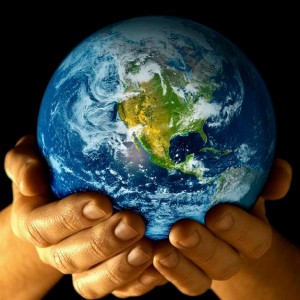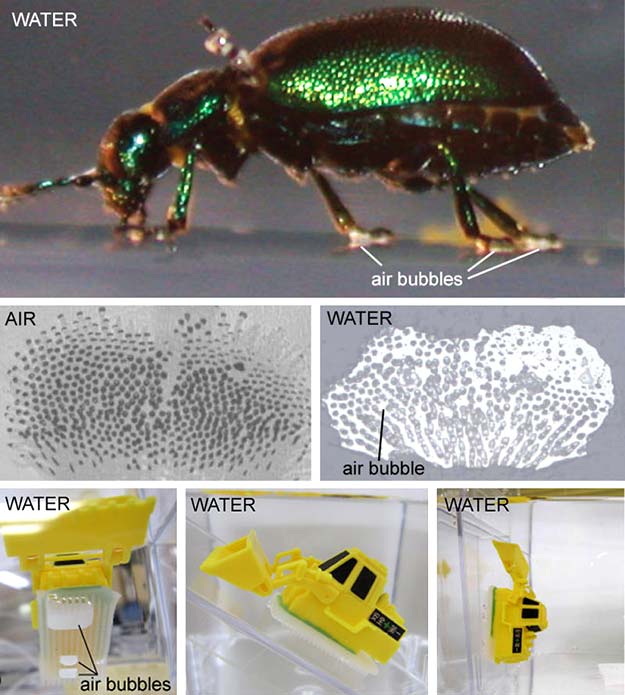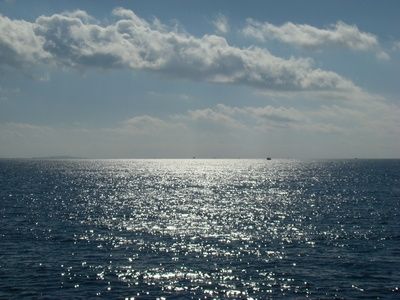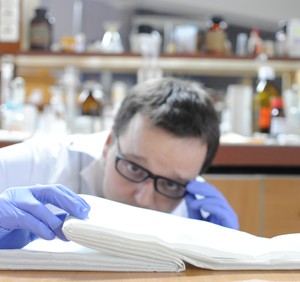She’s Alive… Beautiful… Finite… Hurting… Worth Dying for.
Welcome!
THE SITE POSTS POPULAR ARTICLES, ESSAYS AND OTHER USEFUL INFORMATION ABOUT WATER AS A UNIQUE NATURAL RESOURCE.


About The Earth
How a Leaf Beetle Walks Underwater
Insects are experts when it comes to adhesion on dry surfaces. However, in nature, plants may be covered by water for quite a long period of time, especially after rain. The bionic expert Professor Stanislav Gorb of Kiel University, Germany, and the material scientist Professor Naoe Hosoda of the National Institute for Material Science in Japan, discovered the remarkable ability of the terrestrial leaf beetle to walk underwater. Picking up the beetle’s locomotion mechanism, they designed an artificial material, which sticks to surfaces underwater.
Their scientific results are published August 8 in the online journal Proceedings of the Royal Society B.
“It was a productive collaboration with Naoe Hosoda,” states Gorb. “It is commonly known that adhesion between two solids in air can be produced with the help of water. Just like paper that sticks to table when it gets wet.” The liquid surface tension between air, liquids and solids is called capillary force. In order to stick to dry surfaces insects use such capillary forces with the aid of their oil-covered adhesive setae instead of water. Read more
Seawater is water from a sea or ocean
On average, seawater in the world’s oceans has a salinity of approximately 3.5%, or 35 parts per thousand.
This means that for every 1 litre (1000 mL) of seawater there are 35 grams of salts (mostly, but not entirely, sodium chloride) dissolved in it.
Although a vast majority of seawater is found in oceans with salinity around 3.5%, seawater is not uniformly saline throughout the world.
The planet’s freshest (least saline) sea water is in the eastern parts of Gulf of Finland and in the northern end of Gulf of Bothnia, both part of the Baltic Sea. Read more
Unusual Liquid Crystal Structures On Water Surface
Some liquid crystals form monolayers on water surface. When compressed from sides, such films of monomolecular thickness can wrinkle like fabric on a flat, smooth table, pulled together with palms simultaneously from both sides. With increasing surface pressure, the wrinkles of the monolayer fold up and form subsequent layers. The research on new compounds at the Institute of Physical Chemistry of the Polish Academy of Sciences in Warsaw has resulted in the discovery of new mechanisms of multilayer formation that are responsible for creation of liquid crystal films with a structure that has never been observed before.
After pouring on a water surface, liquid crystals can form ordered layers of monomolecular thickness. When such layers are compressed in their plane, they can form, under appropriate conditions, a film composed of three layers — a trilayer. It was supposed that from time to time even 5-layers may be formed. “The existence of 5-layers has not, however, been well documented. We managed to confirm their presence with high precision. Moreover, we observed 9-layers that until now were considered exclusively as research suggestions,” says Dr Andrzej Żywociński from the Institute of Physical Chemistry of the Polish Academy of Sciences (IPC PAS) in Warsaw. The research findings have been published in Chemistry — A European Journal. Read more
Green Discovery Uses Waste Glass to Clean Up Water
A simple method to convert waste glass into a material which can be used to remove pollutants from contaminated water has been developed by Dr Nichola Coleman from the University of Greenwich’s School of Science.
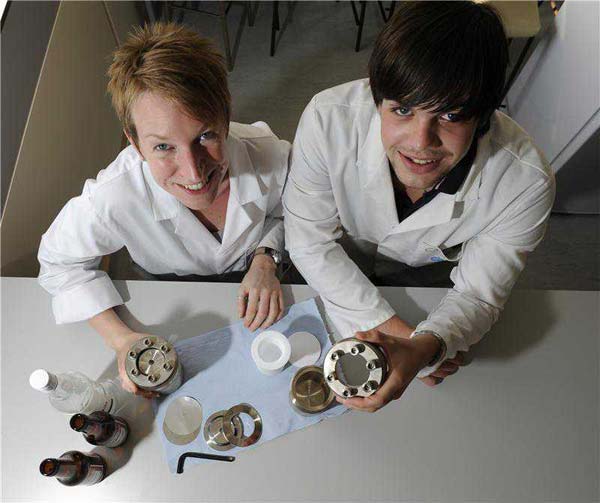 From left: Dr Nichola Coleman and Cameron Abercrombie, final year Chemistry student from the University of Greenwich. (Credit: Image courtesy of University of Greenwich)
From left: Dr Nichola Coleman and Cameron Abercrombie, final year Chemistry student from the University of Greenwich. (Credit: Image courtesy of University of Greenwich)
Nichola Coleman, a Senior Lecturer in Materials Chemistry at the university’s Medway campus says: “The novelty of the research is that the glass can be recycled into something useful — nobody has previously thought to use waste glass in this way.” Read more






